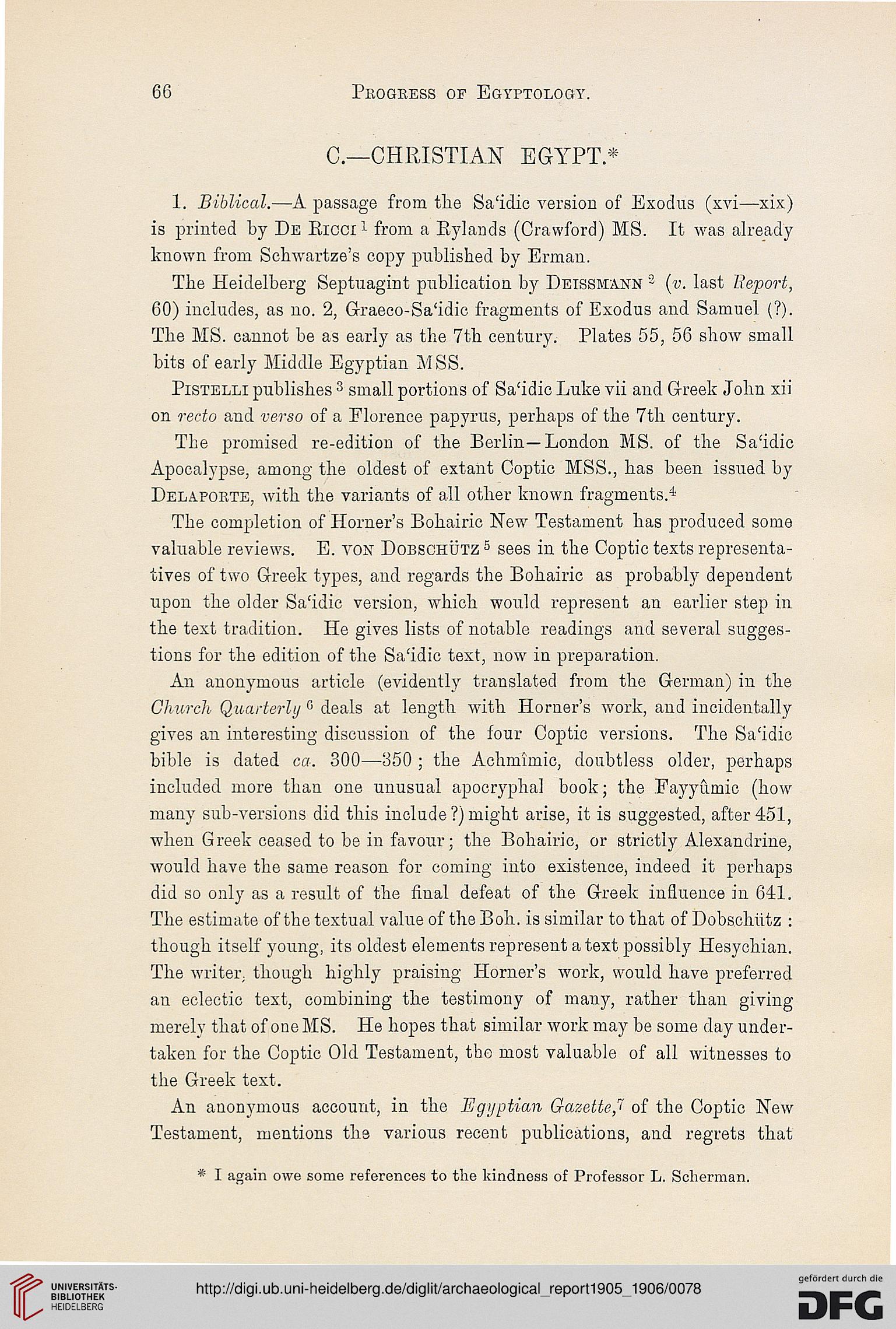66
Progress of Egyptology.
C—CHRISTIAN EGYPT*
1. Biblical.—A passage from the Sa'idic version of Exodus (xvi—xix)
is printed by De Kicci 1 from a Kylands (Crawford) MS. It was already
known from Schwartze's copy published by Erman.
The Heidelberg Septuagint publication by Deissmann 2 (v. last Report,
60) includes, as no. 2, Graeco-Sa'idic fragments of Exodus and Samuel (?).
The MS. cannot be as early as the 7th century. Plates 55, 56 show small
bits of early Middle Egyptian MSS.
Pistelli publishes 3 small portions of Sa'idic Luke vii and Greek John xii
on recto and verso of a Florence papyrus, perhaps of the 7th century.
The promised re-edition of the Berlin—London MS. of the Sa'idic
Apocalypse, among the oldest of extant Coptic MSS., has been issued by
Delapoete, with the variants of all other known fragments.4
The completion of Horner's Bohairic New Testament has produced some
valuable reviews. E. von Dobschutz 5 sees in the Coptic texts representa-
tives of two Greek types, and regards the Bohairic as probably depeudent
upon the older Sa'idic version, which would represent an earlier step in
the text tradition. He gives lists of notable readings and several sugges-
tions for the edition of the Sa'idic text, now in preparation.
An anonymous article (evidently translated from the German) in the
Church Quarterly 0 deals at length with Horner's work, and incidentally
gives an interesting discussion of the four Coptic versions. The Sa'idic
bible is dated ca. 300—350 ; the Achm'imic, doubtless older, perhaps
included more than one unusual apocryphal book; the Eayyumic (how
many sub-versions did this include ?) might arise, it is suggested, after 451,
when Greek ceased to be in favour; the Bohairic, or strictly Alexandrine,
would have the same reason for coming into existence, indeed it perhaps
did so only as a result of the final defeat of the Greek influence in 641.
The estimate of the textual value of the Boh. is similar to that of Dobschutz :
though itself young, its oldest elements represent a text possibly Hesychian.
The writer, though highly praising Horner's work, would have preferred
an eclectic text, combining the testimony of many, rather than giving
merely that of one MS. He hopes that similar work may be some day under-
taken for the Coptic Old Testament, the most valuable of all witnesses to
the Greek text.
An anonymous account, in the Egyptian Gazette,'' of the Coptic New
Testament, mentions tli9 various recent publications, and regrets that
* I again owe some references to the kindness of Professor L. Scherman.
Progress of Egyptology.
C—CHRISTIAN EGYPT*
1. Biblical.—A passage from the Sa'idic version of Exodus (xvi—xix)
is printed by De Kicci 1 from a Kylands (Crawford) MS. It was already
known from Schwartze's copy published by Erman.
The Heidelberg Septuagint publication by Deissmann 2 (v. last Report,
60) includes, as no. 2, Graeco-Sa'idic fragments of Exodus and Samuel (?).
The MS. cannot be as early as the 7th century. Plates 55, 56 show small
bits of early Middle Egyptian MSS.
Pistelli publishes 3 small portions of Sa'idic Luke vii and Greek John xii
on recto and verso of a Florence papyrus, perhaps of the 7th century.
The promised re-edition of the Berlin—London MS. of the Sa'idic
Apocalypse, among the oldest of extant Coptic MSS., has been issued by
Delapoete, with the variants of all other known fragments.4
The completion of Horner's Bohairic New Testament has produced some
valuable reviews. E. von Dobschutz 5 sees in the Coptic texts representa-
tives of two Greek types, and regards the Bohairic as probably depeudent
upon the older Sa'idic version, which would represent an earlier step in
the text tradition. He gives lists of notable readings and several sugges-
tions for the edition of the Sa'idic text, now in preparation.
An anonymous article (evidently translated from the German) in the
Church Quarterly 0 deals at length with Horner's work, and incidentally
gives an interesting discussion of the four Coptic versions. The Sa'idic
bible is dated ca. 300—350 ; the Achm'imic, doubtless older, perhaps
included more than one unusual apocryphal book; the Eayyumic (how
many sub-versions did this include ?) might arise, it is suggested, after 451,
when Greek ceased to be in favour; the Bohairic, or strictly Alexandrine,
would have the same reason for coming into existence, indeed it perhaps
did so only as a result of the final defeat of the Greek influence in 641.
The estimate of the textual value of the Boh. is similar to that of Dobschutz :
though itself young, its oldest elements represent a text possibly Hesychian.
The writer, though highly praising Horner's work, would have preferred
an eclectic text, combining the testimony of many, rather than giving
merely that of one MS. He hopes that similar work may be some day under-
taken for the Coptic Old Testament, the most valuable of all witnesses to
the Greek text.
An anonymous account, in the Egyptian Gazette,'' of the Coptic New
Testament, mentions tli9 various recent publications, and regrets that
* I again owe some references to the kindness of Professor L. Scherman.




